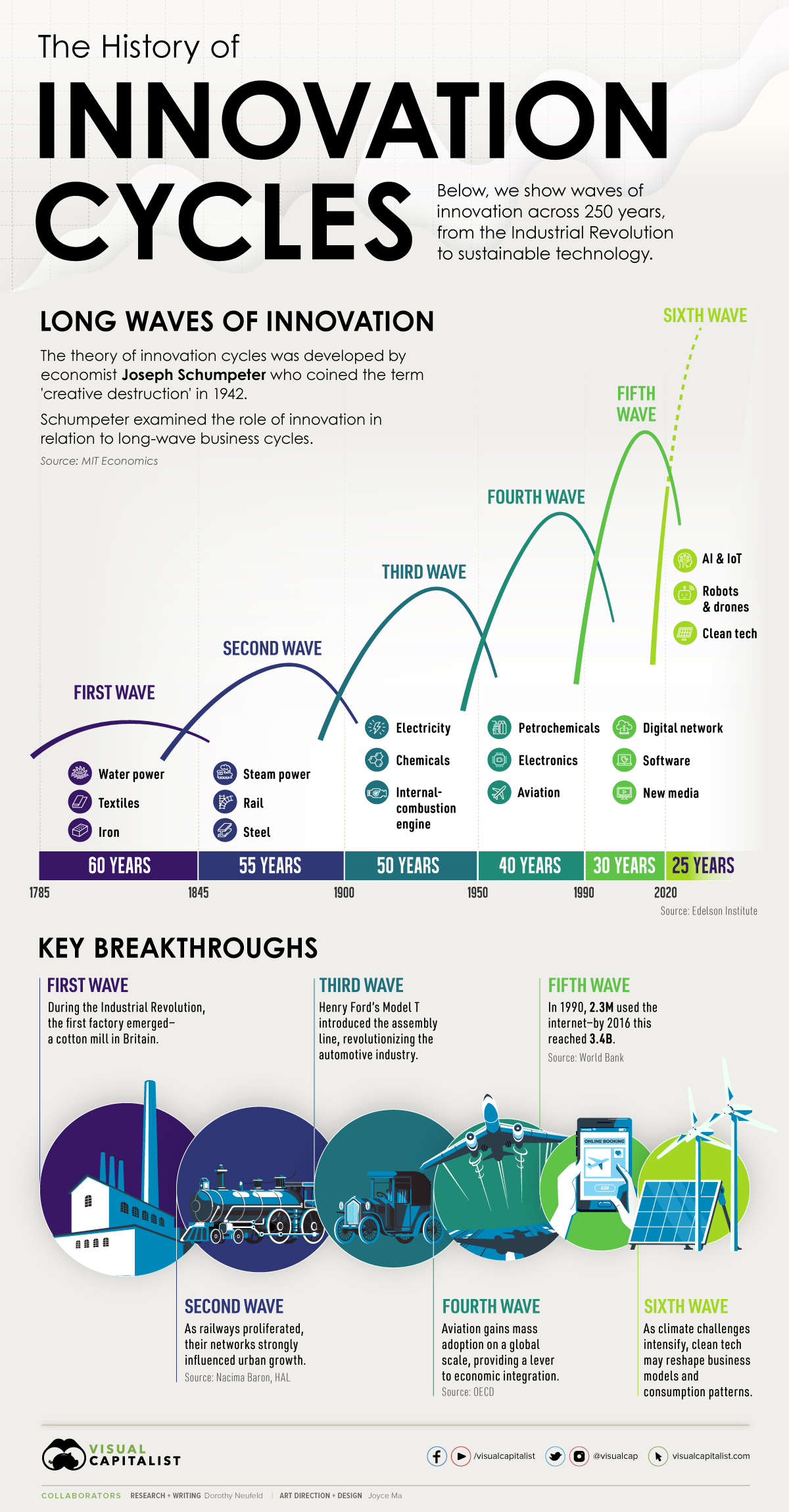
Everything really is cyclical. It’s not just an accepted characteristic of the seasons or fashion (yes, Zennials, people before you thought those jeans were cutting-edge). Apparently, innovation tends to function in cycles, as well.
Many economists believe that we are in the midst of the sixth of wave of innovation, characterized by the digitization of our economy, as well as a priority on clean technology.
What does that mean — and why should you care?
Maybe I should back up a bit.
“Coined by economist Joseph Schumpeter in 1942, the theory of “creative destruction” suggests that business cycles operate under long waves of innovation. Specifically, as markets are disrupted, key clusters of industries have outsized effects on the economy,” Dorothy Neufeld writes for Visual Capitalist.
While creative destruction tends to stimulate the economy, it’s not all good news. Neufield notes that “disruptors can also have a tendency to lead to monopolies. Especially during a cycle’s upswing, the strongest players realize wide margins, establish moats, and fend off rivals. Typically, these cycles begin when the innovations become of general use.” (Looking at you, Big Tech.)
If you’re having difficulty envisioning that, check out this excellent infographic, also courtesy of Visual Capitalist.

Note that each period happens on an accelerated timeline. The first wave, known as the Industrial Revolution, occurred over about 60 years. The fifth wave — centered on the digital networks (AKA the Internet), software, and electronics — happened over the course of three decades. Our current wave kicked off in 2020 (what a rough start), and is estimated to be shortened to a 25-year cycle.
So, um, what are we innovating on in the sixth wave? If you guessed:
AI
drones
robots
and/or tech that address climate change
you would be correct! (And you probably actually read that infographic.)
READ MORE: Ride the wave of the history of American innovation (Visual Capitalist)
So what does that mean in the real world? One obvious conclusion: Your robot butler will be delivered to your home via a driverless Tesla no later than 2030.
In all seriousness, sustainability is top of mind. And that applies to more than just the environment; societal inequities are driving these trends, as well.
“Movements in the market indicate that a new wave of innovation is coming, driven by the depletion of the current model of capitalism and the need for reconfiguration around present environmental and social needs,” Glessia Silva and Luiz Carlos Di Serioa write in Science Direct.

Specifically, according to Silva and Di Seroia, the sixth wave aims to “create an environment where businesses, humankind, and nature can coexist and develop.” (No big deal.)
READ MORE: Learn more about the sixth wave of innovation (Science Direct)
If you’re worried that this will be difficult to accomplish, you’re far from alone. However, history is actually on the side of the optimist, if you believe in creative destruction.
However, that isn’t to say that Big Oil is likely to magnanimously and wisely become Big Solar. The big players in today’s market are unlikely to maintain their prime positions in the new green world order.
That’s because “When waves of innovation put societies on the cusp of change, those most invested in the old ways rarely grasp the speed with which those ways will become obsolete,” Per Espen Stoknes writes in The MIT Press Reader.
But think about this:
“For 200 years, innovators found ingenious ways to improve labor productivity. This was mainly accomplished by having machines (real capital) make people (labor) much more effective per hour,” Espen Stoknes writes. “Now we have a world with more than seven billion people, most wanting work. But on an Earth that’s restrained in what scientists call sources and sinks — or, in more general terms, raw materials and the air, water, land, and vegetation that can absorb carbon emissions and other pollution — it makes plain economic sense to innovate for optimizing resource productivity.”
Basically, if companies want to make $$$, they will be incentivized to shift their business models.
READ MORE: How history could make you more optimistic about our green future (The MIT Press Reader)
If you’re still with me, and you’d really like to nerd out, here are some scholarly articles about Schumpeter’s theory of creative destruction.
If you’re like me and never took microeconomics — but you’re still intrigued — first of all: Good on you! Second, here’s a video explaining the basics of Schumpeter’s theory of creative destruction.

